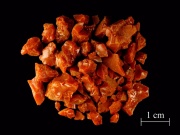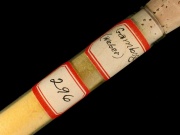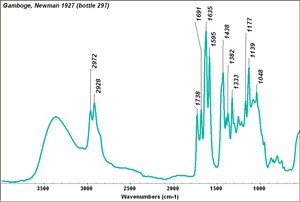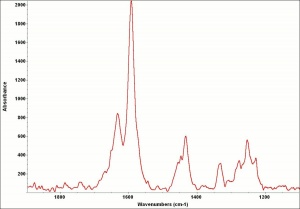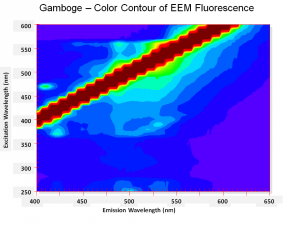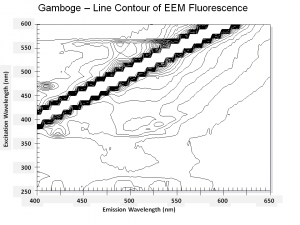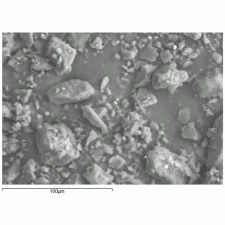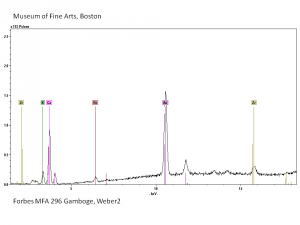Difference between revisions of "Gamboge"
| Line 12: | Line 12: | ||
[[[SliderGallery rightalign|Gamboge 297.TIF~FTIR (MFA)|GambogeUCL.jpg~Raman (UCL)|Gamboge color.PNG~EEM Color|Gamboge line.PNG~EEM Line|f296sem.jpg~SEM|f296edsbw.jpg~EDS|Slide 9 FC296.PNG~XRF]]] | [[[SliderGallery rightalign|Gamboge 297.TIF~FTIR (MFA)|GambogeUCL.jpg~Raman (UCL)|Gamboge color.PNG~EEM Color|Gamboge line.PNG~EEM Line|f296sem.jpg~SEM|f296edsbw.jpg~EDS|Slide 9 FC296.PNG~XRF]]] | ||
| − | == | + | == Physical and Chemical Properties == |
Yellow resinous portion is soluble in ethanol. Colorless carbohydrate portion is soluble in water. Burns with an odor of resin. Turns red in dilute alkali solutions. | Yellow resinous portion is soluble in ethanol. Colorless carbohydrate portion is soluble in water. Burns with an odor of resin. Turns red in dilute alkali solutions. | ||
| Line 18: | Line 18: | ||
The small amorphous particles are transparent in transmitted light. | The small amorphous particles are transparent in transmitted light. | ||
| − | ISO R105 Lightfastness Classification = 2-3 | + | * ISO R105 Lightfastness Classification = 2-3 |
| − | + | * Density = 1.2 | |
| − | + | * Refractive Index = 1.582-1.586 | |
| − | |||
| − | |||
| − | |||
| − | |||
| − | |||
| − | |||
| − | |||
== Hazards and Safety == | == Hazards and Safety == | ||
| Line 34: | Line 27: | ||
Toxic by ingestion. | Toxic by ingestion. | ||
| − | |||
| − | |||
| − | |||
| − | |||
== Additional Images == | == Additional Images == | ||
| Line 46: | Line 35: | ||
File:gamboge_dyed paper.jpg|Gamboge | File:gamboge_dyed paper.jpg|Gamboge | ||
</gallery> | </gallery> | ||
| − | |||
| − | |||
== Sources Checked for Data in Record == | == Sources Checked for Data in Record == | ||
| − | * ''Artists | + | * J.Winter, "Gamboge", ''Artists Pigments'', Volume 3, E. West FitzHugh (ed.), Oxford University Press: Oxford, 1997. |
* ''Encyclopedia Britannica'', http://www.britannica.com Comment: Gamboge. Retrieved June 1, 2003, from Encyclopædia Britannica Premium Service. | * ''Encyclopedia Britannica'', http://www.britannica.com Comment: Gamboge. Retrieved June 1, 2003, from Encyclopædia Britannica Premium Service. | ||
Revision as of 15:04, 30 June 2020
Description
A yellow-orange gum-resin produced by several species of Garcinia tree found in India, Thailand, Cambodia, Vietnam, and Ceylon. Gamboge was used as a yellow pigment as early as the 8th century in Asia and Japan. It was regularly imported to Europe in the 17th century but a few earlier deliveries may have occurred. Gamboge is composed of a yellow resinous component (70-80%; morelloflavone) and a clear water-soluble Gum (20%). Gamboge is marketed in the form of dull, brownish-yellow cakes or lumps. When powdered, it has a rich golden color. Gamboge is used as a transparent colorant in glazes, varnishes, and watercolors. The carbohydrate gum acts as a natural binder. The yellow color fades when exposed to light or Ozone. In some cases it has recovered its color when placed in the dark.
Synonyms and Related Terms
Garcinia sp.; Natural Yellow 24; gomaguta (Esp., Port.); Gummigutt (Deut.); gomme-gutte (Fr.); gomma gutta (It.); giallo Cambogia (It.); gamboji (Jap.); shio (Jap.); kiyo (Jap.); gamboge (Ned., Port.); camboge; cambogia; gum gutta; gutto gumbo; guti ambar; gambogium; rattan yellow; wisteria yellow; gummi-gutti; Siam gamboge; Ceylon gamboge; gokatu gamboge
Physical and Chemical Properties
Yellow resinous portion is soluble in ethanol. Colorless carbohydrate portion is soluble in water. Burns with an odor of resin. Turns red in dilute alkali solutions.
The small amorphous particles are transparent in transmitted light.
- ISO R105 Lightfastness Classification = 2-3
- Density = 1.2
- Refractive Index = 1.582-1.586
Hazards and Safety
Discolors to red with ammonia and other alkali. Fades in sunlight or ozone.
Toxic by ingestion.
Additional Images
Sources Checked for Data in Record
- J.Winter, "Gamboge", Artists Pigments, Volume 3, E. West FitzHugh (ed.), Oxford University Press: Oxford, 1997.
- Encyclopedia Britannica, http://www.britannica.com Comment: Gamboge. Retrieved June 1, 2003, from Encyclopædia Britannica Premium Service.
- The Dictionary of Art, Grove's Dictionaries Inc., New York, 1996 Comment: 'Pigments'
- R. J. Gettens, G.L. Stout, Painting Materials, A Short Encyclopaedia, Dover Publications, New York, 1966
- Ralph Mayer, A Dictionary of Art Terms and Techniques, Harper and Row Publishers, New York, 1969 (also 1945 printing)
- M. Doerner, The Materials of the Artist, Harcourt, Brace & Co., 1934
- R.D. Harley, Artists' Pigments c. 1600-1835, Butterworth Scientific, London, 1982
- F. Crace-Calvert, Dyeing and Calico Printing, Palmer & Howe, London, 1876
- Helmut Schweppe, Schweppe color collection index and information book
- Book and Paper Group, Paper Conservation Catalog, AIC, 1984, 1989
- R.Feller, M.Curran, C.Bailie, 'Identification of Traditional Organic Colorants Employed in Japanese Prints and Determination of their Rates of Fading', Japanese Woodblock Prints, Allen Memorial Art Museum, Oberlin College, Oberlin, 1984
- Website address 1 Comment: "Violin Varnish Glossary" at www.violins.on.ca/luthier.vargloss.html
- CRC Handbook of Chemistry and Physics, Robert Weast (ed.), CRC Press, Boca Raton, Florida, v. 61, 1980 Comment: density=1.2
- Art and Architecture Thesaurus Online, http://www.getty.edu/research/tools/vocabulary/aat/, J. Paul Getty Trust, Los Angeles, 2000
